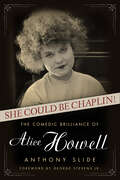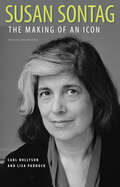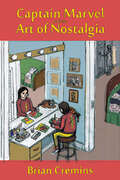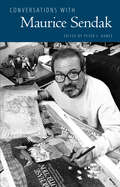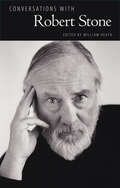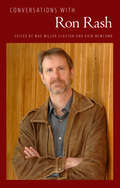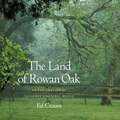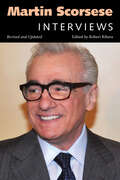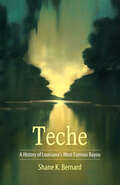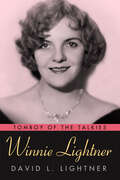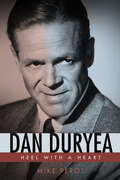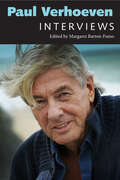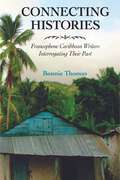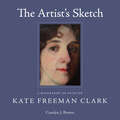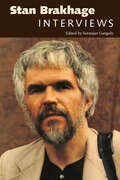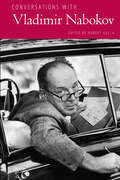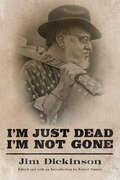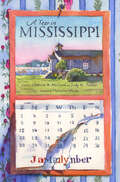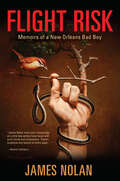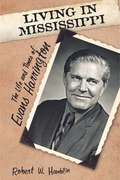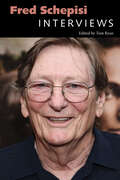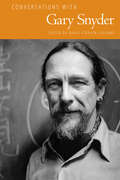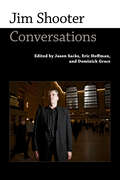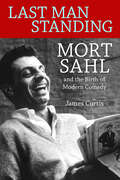- Table View
- List View
She Could Be Chaplin!: The Comedic Brilliance of Alice Howell (Hollywood Legends Series)
by Anthony SlideAlice Howell (1886-1961) is slowly gaining recognition and regard as arguably the most important slapstick comedienne of the silent era. This new study, the first book-length appreciation, identifies her place in the comedy hierarchy alongside the best-known of silent comediennes, Mabel Normand. Like Normand, Howell learned her craft with Mack Sennett and Charlie Chaplin. Beginning her screen career in 1914, Howell quickly developed a distinctive style and eccentric attire and mannerisms, successfully hiding her good looks, and was soon identified as the "Female Charlie Chaplin."Howell became a star of comedy shorts in 1915 and continued her career through 1928 and the advent of sound in film. While she is today recognized as a pioneering female filmmaker, during her career she never expressed much interest in her work, seeing it only as a means to an end, with her income carefully invested in real estate. It has taken many years for her to gain her rightful place in film history, not only as a comedienne, but also as matriarch of a prominent American family that includes son-in-law and director George Stevens and grandson George Stevens Jr., founder of the American Film Institute and the Kennedy Center Honors, who provides a foreword.
Susan Sontag: The Making of an Icon, Revised and Updated
by Lisa Paddock Carl RollysonThis first biography of Susan Sontag (1933–2004) is now fully revised and updated, providing an even more intimate portrayal of the influential writer's life and career. The authors base this revision on Sontag's newly released private correspondence—including emails—and the letters and memoirs of those who knew her best. The authors reveal as never before her early years in Tucson and Los Angeles, her conflicted relationship with her mother, her longing for her absent father, and her precocious achievements at the University of California, Berkeley, and the University of Chicago. Papers, diaries, and lecture notes, many accessible for the first time, spark a passionate fire in this biography. The authors follow Sontag as she abruptly ends an early first marriage, establishes herself in Paris, and embraces the open lifestyle she began as a teenager in Berkeley. As a single mother she struggled with teaching at Columbia University and other colleges while aiming for a career as a novelist and essayist. Eventually she made her own way in New York City after acquiring her one and only publisher, Farrar, Straus & Giroux. In her later years Sontag became a world figure, a tastemaker, dramatist, and political activist who risked her life in besieged Sarajevo. Love affairs with men and women troubled her. Diagnosed with cancer, she responded with determination, and her experience with illness inspired some of her best writing. This biography shows Sontag always craving “more life” at whatever cost and depicts her harrowing final decline even as she resisted terminal cancer. Susan Sontag: The Making of an Icon, Revised and Updated presents in candid and stark relief a new assessment of a heroic and controversial figure.
Captain Marvel and the Art of Nostalgia
by Brian CreminsBilly Batson discovers a secret in a forgotten subway tunnel. There the young man meets a wizard who offers a precious gift: a magic word that will transform the newsboy into a hero. When Billy says, "Shazam!," he becomes Captain Marvel, the World's Mightiest Mortal, one of the most popular comic book characters of the 1940s. This book tells the story of that hero and the writers and artists who created his magical adventures.The saga of Captain Marvel is also that of artist C. C. Beck and writer Otto Binder, one of the most innovative and prolific creative teams working during the Golden Age of comics in the United States. While Beck was the technician and meticulous craftsman, Binder contributed the still, human voice at the heart of Billy's adventures. Later in his career, Beck, like his friend and colleague Will Eisner, developed a theory of comic art expressed in numerous articles, essays, and interviews. A decade after Fawcett Publications settled a copyright infringement lawsuit with Superman's publisher, Beck and Binder became legendary, celebrated figures in comic book fandom of the 1960s.What Beck, Binder, and their readers share in common is a fascination with nostalgia, which has shaped the history of comics and comics scholarship in the United States. Billy Batson's America, with its cartoon villains and talking tigers, remains a living archive of childhood memories, so precious but elusive, as strange and mysterious as the boy's first visit to the subway tunnel. Taking cues from Beck's theories of art and from the growing field of memory studies, Captain Marvel and the Art of Nostalgia explains why we read comics and, more significantly, how we remember them and the America that dreamed them up in the first place.
Conversations with Maurice Sendak (Literary Conversations Series)
by Peter C. KunzeMaurice Sendak (1928–2012) stands out as one of the most respected, influential authors of the twentieth century. Though primarily known as a children’s book writer and illustrator, he did not limit himself to these areas. He saw himself first and foremost as an artist. In this collection of interviews, Sendak presents himself as a writer, illustrator, set designer, and librettist. From his early work with Randall Jarrell and Ruth Krauss through his later work with Tony Kushner and Spike Jonze, Sendak worked as a collaborator with a passion for the arts.The interviews here, many of which are hard to find or previously unpublished, span from 1966 through 2011. They show not only Sendak’s shifting artistic interests, but also changes in how he understood himself and his craft. What emerges is a portrait of an author and an artist who was alternately solemn and playful, congenial and irascible, sophisticated and populist. The man who showed millions of children and adults alike what’s cooking in the night kitchen and where the wild things are, Sendak remains an American original who redefined the picture book and changed children’s literature—and its readers—forever.
Conversations with Robert Stone (Literary Conversations Series)
by William HeathEver since A Hall of Mirrors depicted the wild side of New Orleans in the 1960s, Robert Stone (1937-2015) has situated novels where America has shattered and the action is at a pitch. In Dog Soldiers, he covered the Vietnam War and drug smuggling. A Flag for Sunrise captured revolutionary discontent in Central America. Children of Light exposed the crass values of Hollywood. Outerbridge Reach depicted how existential angst can lead to a longing for heroic transcendence. The clash of religions in Jerusalem drove Damascus Gate. Traditional town-gown tensions amid twenty-first-century culture wars propelled Death of the Black-Haired Girl.Stone's reputation rests on his mastery of the craft of fiction. These interviews are replete with insights about the creative process as he responds with disarming honesty to probing questions about his major works. Stone also has fascinating things to say about his remarkable life--a schizophrenic mother, a stint in the navy, his involvement with Ken Kesey's Merry Pranksters, and his presence at the creation of the counterculture. From the publication of A Hall of Mirrors until his death in 2015, Stone was a major figure in American literature.
Conversations with Ron Rash (Literary Conversations Series)
by Mae Miller Claxton and Rain NewcombSince the publication of Serena in 2008 earned him a nomination for the PEN/Faulkner fiction prize, Ron Rash (b. 1953) has gained attention as one of the South's finest writers. Rash draws upon his family's history in Appalachia, where most members have worked with their hands as farmers or millworkers. In the Grit Lit or Rough South genre, Rash maintains a prominent place as a skilled craftsman and triple threat, publishing four collections of poetry, six short story collections, and six novels. Though best known as an Appalachian writer, Rash's reach has grown to extend well beyond Appalachia and the American South, spreading to an international audience. Conversations with Ron Rash collects twenty-two interviews with the award-winning author and provides a look into Rash's writing career from his first collection of short stories, The Night the New Jesus Fell to Earth in 1994 through his 2015 novel, Above the Waterfall. The collection includes four interviews from outside the United States, two of which appear in English for the first time. Spanning sixteen years, these interviews demonstrate the disciplined writing process of an expert writer, Rash's views of literature on a local and a global scale, his profound respect for the craft of the written word, and his ongoing goal to connect with his readers.
The Land of Rowan Oak: An Exploration of Faulkner's Natural World
by Ed CroomThe plants and landscape at Rowan Oak are the “little postage stamp of soil” that William Faulkner owned, walked, and tended for over thirty years during the writing of many of his short stories and novels. Faulkner saw and smelled the earth and listened to sounds from the cultivated grounds and the surrounding woods. This is the place that offered him refuge for writing and provided him food from its garden, fruit and nut trees, and pasture for his horses and a milk cow. Rowan Oak boasts a diverse landscape, encompassing an aristocratic eastern redcedar-lined drive and walk as well as hardy ornamental shrubs, trees, pastures, and a hardwood forest with virgin timber. More than fifty years after Faulkner's death, Rowan Oak remains a sanctuary and a place of mystery and beauty nestled in the midst of Oxford, Mississippi. The photographs in The Land of Rowan Oak are botanist Ed Croom's exploration and documentation of the changes in the plants and landscape over more than a decade. Croom encountered early morning mists, the summer heat and haze, and even rare snowfalls in his near-daily walks on the grounds. His photographs record a decaying fence line, trees and plants that have since disappeared, and the newly restored sunken garden. This book honors the land Faulkner loved. While Faulkner's novels have left an indelible legacy in southern and American letters, the landscape of his beloved home also serves as a record of the botanical history of this most storied corner of the American literary South.
Martin Scorsese: Interviews, Revised and Updated (Conversations with Filmmakers Series)
by Robert RiberaMartin Scorsese (b. 1942) has long been considered one of America’s greatest cinematic storytellers. Over the last fifty years he has created some of the most iconic moments in American film, never afraid to confront controversial issues with passion. While few of his films are directly autobiographical, his upbringing in New York’s Little Italy, the childhood asthma that kept him from playing sports, and his early desire to enter the priesthood all helped form his sensibilities and later shaped his distinct style. Community, religion, violence—these themes drive a Scorsese picture, and whether he examines the violence that bursts forth in the hand of Travis Bickle or the passion of Jesus Christ, Scorsese’s mastery of the history, art, and craft of filmmaking is undeniable. This collection was originally edited by the late Peter Brunette in 1999 and is now revised and extensively updated by Robert Ribera. It traces Scorsese’s evolution from the earliest days of the New American Cinema, his work with Roger Corman, and his days at New York University’s film program to his efforts to preserve the legacy of cinema, his documentary work, and his recent string of successes. Among new movies discussed are The Departed, Hugo, and The Wolf of Wall Street, and the documentaries No Direction Home and The Blues. Scorsese stands out as a director, producer, scholar, preservationist, and icon. His work both behind the camera and in the service of its history are a cornerstone of American and world cinemas. In these interviews, Scorsese takes us from Elizabeth Street to the heights of Hollywood and all the journeys in between.
Teche: A History of Louisiana's Most Famous Bayou (America's Third Coast Series)
by Shane K. BernardRecipient of a 2017 Book of the Year Award presented by the Louisiana Endowment for the HumanitiesShane K. Bernard's Teche examines this legendary waterway of the American Deep South. Bernard delves into the bayou's geologic formation as a vestige of the Mississippi and Red Rivers, its prehistoric Native American occupation, and its colonial settlement by French, Spanish, and, eventually, Anglo-American pioneers. He surveys the coming of indigo, cotton, and sugar; steam-powered sugar mills and riverboats; and the brutal institution of slavery. He also examines the impact of the Civil War on the Teche, depicting the running battles up and down the bayou and the sporadic gunboat duels, when ironclads clashed in the narrow confines of the dark, sluggish river.Describing the misery of the postbellum era, Bernard reveals how epic floods, yellow fever, racial violence, and widespread poverty disrupted the lives of those who resided under the sprawling, moss-draped live oaks lining the Teche's banks. Further, he chronicles the slow decline of the bayou, as the coming of the railroad, automobiles, and highways reduced its value as a means of travel. Finally, he considers modern efforts to redesign the Teche using dams, locks, levees, and other water-control measures. He examines the recent push to clean and revitalize the bayou after years of desecration by litter, pollutants, and invasive species. Illustrated with historic images and numerous maps, this book will be required reading for anyone seeking the colorful history of Louisiana and the Gulf Coast.As a bonus, the second part of the book describes Bernard's own canoe journey down the Teche's 125-mile course. This modern personal account from the field reveals the current state of the bayou and the remarkable people who still live along its banks.
Winnie Lightner: Tomboy of the Talkies (Hollywood Legends Series)
by David L. LightnerWinnie Lightner (1899–1971) stood out as the first great female comedian of the talkies. Blessed with a superb singing voice and a gift for making wisecracks and rubber faces, she rose to stardom in vaudeville and on Broadway. Then, at the dawn of the sound era, she became the first person in motion picture history to have her spoken words, the lyrics to a song, censored. In Winnie Lightner: Tomboy of the Talkies, David L. Lightner shows how Winnie Lightner's hilarious performance in the 1929 musical comedy Gold Diggers of Broadway made her an overnight sensation. She went on to star in seven other Warner Bros. features. In the best of them, she was the comic epitome of a strident feminist, dominating men and gleefully spurning conventional gender norms and moral values. So tough was she, the studio billed her as “the tomboy of the talkies.” When the Great Depression rendered moviegoers hostile toward feminism, Warner Bros. tried to craft a new image of her as glamorous and sexy. Executives assigned her contradictory roles in which she was empowered in the workplace but submissive to her male partner at home. The new persona flopped at the box office, and Lightner's stardom ended. In four final movies, she played supporting roles as the loudmouthed roommate and best friend of actresses Loretta Young, Joan Crawford, and Mona Barrie. Following her retirement in 1934, Lightner faded into obscurity. Many of her films were damaged or even lost entirely. At long last, this biography gives Winnie Lightner the recognition she deserves as a notable figure in film history, in women's history, and in the history of show business.
Dan Duryea: Heel with a Heart (Hollywood Legends Series)
by Mike PerosDan Duryea (1907–1968) made a vivid impression on moviegoers with his first major screen appearance as the conniving Leo Hubbard in 1941's classic melodrama The Little Foxes. His subsequent film and television career would span from 1941 until his death. Duryea remains best known for the nasty, scheming villains he portrayed in such noir masterpieces as Scarlet Street, Criss Cross, and The Woman in the Window. In each of these, he wielded a blend of menace, sleaze, confidence, and surface charm. This winning combination led him to stardom and garnered him the adoration of female fans, even though Duryea's onscreen brutality so often targeted female characters. Yet this biography's close examination of Duryea's oeuvre finds him excelling in various roles in many genres—war films, westerns, crime dramas, and even the occasional comedy. Dan Duryea: Heel with a Heart is a full-scale, comprehensive biography that examines the tension between Duryea's villainous screen image and his Samaritan personal life. At home, he proved to be one of Hollywood's most honorable and decent men. Duryea remained married to the former Helen Bryan from 1931 until her death in 1967. A dedicated family man, he and Helen took an active role in raising their children and in the community. In his career, Duryea knew villainous roles were what the public wanted—there would be a public backlash if fans read an article depicting what a decent guy he was. Frustrated that he couldn't completely shake his screen image and public persona, he wrestled with this restriction throughout his career. Producers and the public did not care to follow any new directions he hoped to pursue. This book, written with Duryea's surviving son Richard's cooperation, fully explores the life and legacy of a Hollywood icon ready for rediscovery.
Paul Verhoeven: Interviews (Conversations with Filmmakers Series)
by Margaret Barton-FumoAfter a robust career in the Netherlands as the country's most successful director, Paul Verhoeven (b. 1938) built an impressive career in the United States with such controversial blockbusters as RoboCop, Total Recall, Basic Instinct, Starship Troopers, and Showgirls before returning home to direct 2006's Black Book. After a recent stint as a reality television judge in the Netherlands, Verhoeven returned to the big screen with his first feature film in a decade, a highly anticipated French-language production, Elle, starring Isabelle Huppert.Verhoeven, who holds an advanced degree in mathematics and physics, boasts a fascinating background. Traversing Hollywood, the Dutch film industry, and now French filmmaking, the interviews in this volume reveal a complex, often ambiguous figure, as well as a director of immense talent.Paul Verhoeven: Interviews covers every phase of the director's career, beginning with six newly translated Dutch newspaper interviews dating back to 1968 and ending with a set of previously unpublished interviews dedicated to his most recent work. He experimented with crowd-sourced filmmaking for the television show The Entertainment Experience, which resulted in the film Tricked, as well as his latest feature Elle. Editor Margaret Barton-Fumo includes "Sex, Cinema and Showgirls," a long out-of-print essay by Verhoeven on his most controversial film, accompanied by pages of original storyboards from this and some of Verhoeven's other films. Finally, Barton-Fumo allots due attention to the director's little-known lifelong fascination with the historical Jesus Christ. Verhoeven is the only non-theologian member of the exclusive Westar Institute and author of the book Jesus of Nazareth.
Connecting Histories: Francophone Caribbean Writers Interrogating Their Past (Caribbean Studies Series)
by Bonnie ThomasThe Francophone Caribbean boasts a trove of literary gems. Distinguished by innovative, elegant writing and thought-provoking questions of history and identity, this exciting body of work demands scholarly attention. Its authors treat the traumatic legacies of shared and personal histories pervading Caribbean experience in striking ways, delineating a path towards reconciliation and healing. The creation of diverse personal narratives—encompassing autobiography, autofiction (heavily autobiographical fiction), travel writing, and reflective essay—remains characteristic of many Caribbean writers and offers poignant illustrations of the complex interchange between shared and personal pasts and how they affect individual lives. Through their historically informed autobiography, the authors in this study—Maryse Condé, Gisèle Pineau, Patrick Chamoiseau, Edwidge Danticat, and Dany Laferrière—offer compelling insights into confronting, coming to terms with, and reconciling their past. The employment of personal narratives as the vehicle to carry out this investigation points to a tension evident in these writers’ reflections, which constantly move between the collective and the personal. As an inescapably complex network, their past extends beyond the notion of a single, private life. These contemporary authors from Martinique, Guadeloupe, and Haiti intertwine their personal memories with reflections on the histories of their homelands and on the European and North American countries they adopt through choice or necessity. They reveal a multitude of deep connections that illuminate distinct Francophone Caribbean experiences.
The Artist's Sketch: A Biography of Painter Kate Freeman Clark
by Carolyn J. BrownArtist Kate Freeman Clark (1875–1957) left behind over one thousand paintings now stored at a gallery bearing her name in her hometown of Holly Springs, Mississippi. But it was not until after her death in 1957 at the age of eighty-one that citizens even discovered that she was a painter of considerable stature. In her will, Clark left the city her family home, her paintings stored at a warehouse in New York for over forty years, and money to build a gallery, much to the surprise of the Holly Springs community. As a young woman, Clark studied art in New York and took classes with some of the greatest American artists of the day. From the start Clark approached the study of art with discipline and tenacity. She learned from William Merritt Chase when he opened his own school in 1895. For six consecutive summers at his Shinnecock Summer School of Art in Long Island, she mastered the plein air technique. Chase trained many female students, yet he recognized Clark as “his most talented pupil.” The book prints, for the first time, excerpts from Clark's delightful journal of the artist's experience at Chase's school, giving readers firsthand reporting of an artist-led school in the early twentieth century. Clark returned to Holly Springs in 1923. Mysteriously, sadly, she never resumed painting and lived the last years of her life in quietude. The Artist's Sketch shines a light on Clark, finally bringing her out of obscurity. This book also introduces Clark's art to a new generation of readers and highlights current projects and important work being done in Holly Springs by the Kate Freeman Clark Art Gallery and the Marshall County Historical Museum, the two institutions that, since her death, have worked hard to keep Kate Freeman Clark's legacy alive.
Stan Brakhage: Interviews (Conversations with Filmmakers Series)
by Suranjan GangulyIn this volume, editor Suranjan Ganguly collects nine of Stan Brakhage’s most important interviews in which the filmmaker describes his conceptual frameworks; his theories of vision and sound; the importance of poetry, music, and the visual arts in relation to his work; his concept of the muse; and the key influences on his art-making. In doing so, Brakhage (1933–2003) discusses some of his iconic films, such as Anticipation of the Night, Dog Star Man, Scenes from Under Childhood, Mothlight, and The Text of Light.One of the most innovative filmmakers in the history of experimental cinema, Brakhage made almost 350 films in his fifty-two-year-long career. These films include psychodramas, autobiography, Freudian trance films, birth films, song cycles, meditations on light, and hand-painted films, which range from nine seconds to over four hours in duration. Born in Kansas City, Missouri, he lived most of his life in the mountains of Colorado, teaching for twenty-one years in the film studies program at the University of Colorado, Boulder.As a filmmaker, Brakhage’s life-long obsession with what he called an “adventure in perception” made him focus on the act of seeing itself, which he tried to capture on film in multiple ways both with and without his camera and by scratching and painting on film. Convinced that there is a primary level of cognition that precedes language, he wrote of the “untutored eye” with which children can access ineffable visual realities. Adults, who have lost such primal sight, can “retrain” their eyes by becoming conscious of what constitutes true vision and the different ways in which they daily perceive the world. Brakhage’s films experiment with such perceptions, manipulating visual and auditory experience in ways that continue to influence film today.
Hazel Brannon Smith: The Female Crusading Scalawag
by Jeffery B. HowellHazel Brannon Smith (1914-1994) stood out as a prominent white newspaper owner in Mississippi before, during, and after the civil rights movement. As early as the mid-1940s, she earned state and national headlines by fighting bootleggers and corrupt politicians. Her career was marked by a progressive ethic, and she wrote almost fifty years of columns with the goal of promoting the health of her community.In the first half of her career, she strongly supported Jim Crow segregation. Yet, in the 1950s, she refused to back the economic intimidation and covert violence of groups such as the Citizens" Council. The subsequent backlash led her to being deemed a social pariah, and the economic pressure bankrupted her once-flourishing newspaper empire in Holmes County. Rejected by the white establishment, she became an ally of the black struggle for social justice.Smith's biography reveals how many historians have miscast white moderates of this period. Her peers considered her a liberal, but her actions revealed the firm limits of white activism in the rural South during the civil rights era. While historians have shown that the civil rights movement emerged mostly from the grass roots, Smith's trajectory was decidedly different. She never fully escaped her white paternalistic sentiments, yet during the 1950s and 1960s she spoke out consistently against racial extremism. This book complicates the narrative of the white media and business people responding to the movement's challenging call for racial justice.
Conversations with Vladimir Nabokov (Literary Conversations Series)
by Robert GollaConversations with Vladimir Nabokov brings together candid, revealing interviews with one of the twentieth century’s master prose writers. Vladimir Nabokov (1899–1977) was a Russian American scientist, poet, translator, and professor of literature. Critics throughout the world celebrated him for developing the luminous and enigmatic style that advanced the boundaries of modern literature more than any author since James Joyce. In a career that spanned over six decades, he produced dozens of iconic works, including Lolita, Pale Fire, Ada, and his classic autobiography, Speak, Memory.The twenty-eight interviews and profiles in this collection were drawn from Nabokov’s numerous print and broadcast appearances over a period of nineteen years. Beginning with the controversy surrounding the American publication of Lolita in 1958, he offers trenchant, witty views on society, literature, education, the role of the author, and a range of other topics. He discusses the numerous literary and symbolic allusions in his work, his use of parody and satire, as well as analyses of his own literary influences.Nabokov also provided a detailed portrait of his life—from his aristocratic childhood in prerevolutionary Russia, education at Cambridge, apprenticeship as an émigré writer in the capitals of Europe, to his decision in 1940 to immigrate to the United States, where he achieved renown and garnered an international readership. The interviews in this collection are essential for seeking a clearer understanding of the life and work of an author who was pivotal in shaping the landscape of contemporary fiction.
I'm Just Dead, I'm Not Gone (American Made Music Series)
by Jim DickinsonI'm Just Dead, I'm Not Gone chronicles Jim Dickinson's extraordinary life in the Memphis music scene of the fifties and sixties and how he went on to play with and produce a rich array of artists, including Aretha Franklin, the Rolling Stones, Ry Cooder, Duane Allman, Arlo Guthrie, and Albert King. With verve and wit, Dickinson (1941–2009) describes his trip to Blind Lemon's grave on the Texas flatlands as a college student and how that encounter inspired his return to Memphis. Back home, he looked up Gus Cannon and Furry Lewis, began staging plays, cofounded what would become the annual Memphis Blues Festival, and started recording. The blues, Elvis, and early rock 'n' roll compelled Dickinson to reject racial barriers and spurred his contributions to the Memphis music and experimental art scene. He explains how the family yardman, WDIA, Dewey Phillips, Furry Lewis, Will Shade, and Howlin' Wolf shaped him and recounts how he went on to learn his craft at Sun, Ardent, American, Muscle Shoals, and Criteria studios from master producers Sam Phillips, John Fry, Chips Moman, and Jerry Wexler. Dickinson is a member of the Mississippi Music Hall of Fame and an inaugural inductee of the Memphis Music Hall of Fame. He has received the Lifetime Achievement Award for Engineering and Production from the Americana Music Association, a Brass Note on the Beale Street Walk of Fame in Memphis, and a Heritage Marker on the Mississippi Blues Trail. This memoir recounts a love affair with Memphis, the blues, and rock 'n' roll through Dickinson's captivating blend of intelligence, humor, and candor.
A Year in Mississippi
by Charline R. McCord and Judy H. TuckerWith contributions by Walter Biggins, Patti Carr Black, Lottie Brent Boggan, Donald H. Butts, Bob Carskadon, Rebecca Lauck Cleary, David Creel, Sylvia Nettles Dickson, Pat Flynn, Chris Gilmer, Peggy Gilmer-Piasecki, Carolyn Haines, Ann Tyrone Hebert, C. C. Henley, Alice Jackson, Donald M. Kartiganer, Janice Marie Kraft, Francis X. Kuhn, Bill Luckett, Johnnie Mae Maberry, Debbie Campbell Matthews, Charline R. McCord, Jo McDivitt, Cheri Thornton McHugh, Thomas McIntyre, Margaret McMullan, Willie Morris, Julia Reed, Ronnie Riggs, Sid Salter, David Sheffield, Mary Sue Slagle, Seetha Srinivasan, Brenda Trigg, Judy H. Tucker, Cynthia Walker, Lawrence “Larry” Wells, Jacqueline Freeman Wheelock, Malcolm White, Diane Williams, and Richard Wiman A Year in Mississippi presents a collection of forty essays, ten per season, celebrating significant events and traditions throughout the state. Writers showcase the background, history, and emotions of these events and traditions with special meaning. Each event shines in the spotlight, observed not only to ascertain its impact, but also to discover why it succeeds, how it contributes to and shapes a unique culture, and how it functions to bind people together. Well-known contributors and essays of special interest in the collection include Willie Morris’s “The Glory of the Game,” Julia Reed’s “Green Day,” Lawrence “Larry” Wells’s “Always on My Mind—A Blues and Civil Rights Tour of the Mississippi Delta,” Donald M. Kartiganer’s “Faulkner and Yoknapatawpha 1974-2016,” Margaret McMullan’s “Christmas in the Pass,” Sid Salter’s “The Neshoba County Fair: Porches, Politicians, and Pie,” Patti Carr Black’s “Whiskey Christmases,” Carolyn Haines’s “Camp Meeting,” David Sheffield’s “The Blessing of the Fleet” and Seetha Srinivasan’s “Diwali: Hindu Festival of Lights.”
Flight Risk: Memoirs of a New Orleans Bad Boy (Willie Morris Books in Memoir and Biography)
by James Nolan"James Nolan looks back unsparingly on a time few writers have faced with such clarity and compassion. There's suspense and beauty on every page . . ."--Andrei CodrescuFlight Risk takes off as a page-turning narrative with deep roots and a wide wingspan. James Nolan, a fifth-generation New Orleans native, offers up an intimate portrait both of his insular hometown and his generation's counterculture. Flight runs as a theme throughout the book, which begins with Nolan's escape from the gothic mental hospital to which his parents committed the teenaged poet during the tumult of 1968. This breakout is followed by the self-styled revolutionary's hair-raising flight from a Guatemalan jail, and years later, by the author's bolt from China, where he ditched his teaching position and collectivist ideals. These Houdini-like feats foreshadow a more recent one, how he dodged biblical floods in a stolen school bus three days after Hurricane Katrina hit New Orleans.Nolan traces these flight patterns to those of his French ancestors who fled to New Orleans in the mid-nineteenth century, established a tobacco business in the French Quarter, and kept the old country alive in their Creole demimonde. The writer describes the eccentric Seventh Ward menagerie of the extended family in which he grew up, his early flirtation with extremist politics, and a strong bond with his freewheeling grandfather, a gentleman from the Gilded Age. Nolan's quest for his own freedom takes him to the flower-powered, gender-bending San Francisco of the sixties and seventies, as well as to an expatriate life in Spain during the heady years of that nation's transition to democracy. Like the prodigal son, he eventually returns home to live in the French Quarter, around the corner from where his grandmother grew up, only to struggle through the aftermath of Katrina and the city's resurrection.Many of these stories are entwined with the commentaries of a wry flaneur, addressing such subjects as the nuances of race in New Orleans, the Disneyfication of the French Quarter, the numbing anomie of digital technology and globalization, the challenges of caring for aging parents, Creole funeral traditions, how to make a soul-searing gumbo, and what it really means to belong.
Living in Mississippi: The Life and Times of Evans Harrington
by Robert W. HamblinRobert W. Hamblin elevates Evans Harrington (1925-1997), as well as his remarkable achievements and writings, introducing his legacy to a new generation. Harrington continually found himself in conflict with the conservative, and often reactionary, institutions of his society--be they educational, political, or religious. Yet unlike many Mississippi liberals and moderates of his day--white as well as black--Harrington did not leave the state for a freer environment or better opportunities elsewhere. Except for his military service, he stayed in Mississippi his entire life, and his presence made a difference.In 1962, Harrington openly supported the enrollment of James Meredith, the first African American student to attend Ole Miss. In 1965, he invited African American students from Tougaloo College to attend the Southern Literary Festival hosted by Ole Miss--the first meeting of that organization to be integrated. In 1972, as faculty sponsor of Images, the Ole Miss literary journal, he joined his student writers in a successful suit against the university's attempt to suppress an issue of the magazine that contained controversial content. In 1996, Harrington united with other ACLU members to support the cause of Lisa Herdahl, who had brought suit against the North Pontotoc, Mississippi, School Board for allowing sectarian prayers and devotionals in public school classrooms. Hamblin presents these and other examples, showing Harrington both as an exception to and as a representative figure of his time and place.This biography also explores Harrington and his writings, which include "Living in Mississippi," a personal essay about being a white liberal in segregated Mississippi; several short stories; a novel, The Prisoners; and three popular novels issued under the pseudonym Gilbert Terrell: Willa, Missy, and Lily, as well as a number of unpublished manuscripts. Harrington also coedited, with Ann J. Abadie, four volumes of papers presented at the annual Faulkner and Yoknapatawpha Conference, which he cofounded.
Fred Schepisi: Interviews (Conversations with Filmmakers Series)
by Tom RyanIn the New Yorker, Stephen Schiff has described Fred Schepisi (b. 1939) as “probably the least-known great director working in the mainstream American cinema—a master storyteller with a serenely muscular style that can make more flamboyant moviemakers look coarse and overweening.” Schepisi’s launch in Australia during the country’s film renaissance of the 1970s and his ongoing international work have rightfully earned him a reputation as an actors’ director. But he has also become a skillful stylist, forging his own way as he works alongside a talented team of collaborators. This volume includes twenty interviews with Schepisi and two with longtime collaborators, cinematographer Ian Baker and composer Paul Grabowsky. The interviews trace the filmmaker’s career from his beginnings in advertising, through his two early Australian features—The Devil's Playground and The Chant of Jimmie Blacksmith—to his subsequent work in the United States and beyond on films as various as Plenty, Roxanne, A Cry in the Dark, The Russia House, Six Degrees of Separation, Empire Falls, Last Orders, and Eye of the Storm. Schepisi’s films are diverse thematically and visually. In what is effectively a master class on film direction, Schepisi discusses his creative choices and his work with actors and collaborators behind the scenes. In the process, he provides a goldmine of insights into his films, his filmmaking style, and what makes him tick as an artist.
Conversations with Gary Snyder (Literary Conversations Series)
by David Stephen CalonneGary Snyder (b. 1930) is one of the most distinguished American poets, remarkable both for his long and productive career and for his equal contributions to literature and environmental thought. His childhood in the Pacific Northwest profoundly shaped his sensibility due to his contact with Native American culture and his early awareness of the destruction of the environment by corporations. Although he emerged from the San Francisco Renaissance with writers such as Kenneth Rexroth, Robert Duncan, and William Everson, he became associated with the Beats due to his friendships with Allen Ginsberg and Jack Kerouac, who included a portrait of Snyder as Japhy Ryder in his novel The Dharma Bums. After graduating from Reed College, Snyder became deeply involved with Zen Buddhism, and he spent twelve years in Japan immersed in study.Conversations with Gary Snyder collects interviews from 1961 to 2015 and charts his developing environmental philosophy and his wide-ranging interests in ecology, Buddhism, Native American studies, history, and mythology. The book also demonstrates the ways Snyder has returned throughout his career to key ideas such as the extended family, shamanism, poetics, visionary experience, and caring for the environment as well as his relationship to the Beat movement. Because the book contains interviews spanning more than fifty years, the reader witnesses how Snyder has evolved and grown both as a poet and philosopher of humanity's proper relationship to the cosmos while remaining committed to the issues that preoccupied him as a young man.
Jim Shooter: Conversations (Conversations with Comic Artists Series)
by Jason Sacks, Eric Hoffman, and Dominick GraceAs an American comic book writer, editor, and businessman, Jim Shooter (b. 1951) remains among the most important figures in the history of the medium. Starting in 1966 at the age of fourteen, Shooter, as the young protégé of verbally abusive DC editor Mort Weisinger, helped introduce themes and character development more commonly associated with DC competitor Marvel Comics. Shooter created several characters for the Legion of Super-Heroes, introduced Superman’s villain the Parasite, and jointly devised the first race between the Flash and Superman. When he later ascended to editor-in-chief at Marvel Comics, the company, indeed the medium as a whole, was moribund. Yet by the time Shooter left the company a mere decade later, the industry had again achieved considerable commercial viability, with Marvel dominating the market. Shooter enjoyed many successes during his tenure, such as Chris Claremont and John Byrne’s run on the Uncanny X-Men, Byrne’s work on the Fantastic Four, Frank Miller’s Daredevil stories, Walt Simonson’s crafting of Norse mythology in Thor, and Roger Stern’s runs on Avengers and The Amazing Spider-Man, as well as his own successes writing Secret Wars and Secret Wars II. After a rift at Marvel, Shooter then helped lead Valiant Comics into one of the most iconic comic book companies of the 1990s, before moving to start-up companies Defiant and Broadway Comics. Included here is a 1969 interview that shows a restless teenager; the 1973 interview that returned Shooter to comics; a discussion from 1980 during his pinnacle at Marvel; and two conversations from his time at Valiant and Defiant Comics. At the close, an extensive, original interview encompasses Shooter’s full career.
Last Man Standing: Mort Sahl and the Birth of Modern Comedy
by James CurtisA Times Literary Supplement 2017 Book of the YearOn December 22, 1953, Mort Sahl (1927–2021) took the stage at San Francisco's hungry i and changed comedy forever. Before him, standup was about everything but hard news and politics. In his wake, a new generation of smart comics emerged—Shelley Berman, Mike Nichols and Elaine May, Lenny Bruce, Bob Newhart, Dick Gregory, Woody Allen, and the Smothers Brothers, among others. He opened up jazz-inflected satire to a loose network of clubs, cut the first modern comedy album, and appeared on the cover of Time surrounded by caricatures of some of his frequent targets such as Dwight Eisenhower, Richard Nixon, Adlai Stevenson, and John F. Kennedy. Through the extraordinary details of Sahl's life, author James Curtis deftly illustrates why Sahl was dubbed by Steve Allen as “the only real political philosopher we have in modern comedy.”Sahl came on the scene the same year Eisenhower and Nixon entered the White House, the year Playboy first hit the nation's newsstands. Clad in an open collar and pullover sweater, he adopted the persona of a graduate student ruminating on current events. “It was like nothing I'd ever seen,” said Woody Allen, “and I've never seen anything like it after.” Sahl was billed, variously, as the Nation's Conscience, America's Only Working Philosopher, and, most tellingly, the Next President of the United States. Yet he was also a satirist so savage the editors of Time once dubbed him “Will Rogers with fangs.”Here, for the first time, is the whole story of Mort Sahl, America's iconoclastic father of modern standup comedy. Written with Sahl's full cooperation and the participation of many of his friends and contemporaries, it delves deeply into the influences that shaped him, the heady times in which he soared, and the depths to which he fell during the turbulent sixties when he took on the Warren Commission and nearly paid for it with his career.
